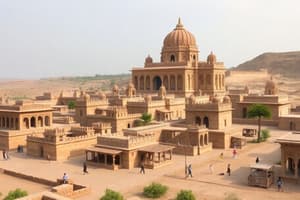Podcast
Questions and Answers
What evidence suggests the existence of a well-developed trade system in the Harappan civilization?
What evidence suggests the existence of a well-developed trade system in the Harappan civilization?
- The use of steatite seals for decorative purposes
- The discovery of intricate gold jewelry
- The presence of copper-colored pottery in graves
- The presence of identical seal marks at multiple locations (correct)
What does the pottery found at Lothal suggest about the Harappan civilization's craft skills?
What does the pottery found at Lothal suggest about the Harappan civilization's craft skills?
- They had a basic understanding of pottery making
- They were skilled in producing highly polished and decorated ceramics (correct)
- They lacked the ability to create intricate pottery designs
- They only produced plain red ware pottery
Which of the following best describes the social structure of the Harappan civilization?
Which of the following best describes the social structure of the Harappan civilization?
- There is no evidence to suggest any form of social hierarchy
- It had a hierarchical structure with distinct social classes (correct)
- It was a society dominated by a single ruling class
- It was an egalitarian society with no social stratification
What type of jewelry was commonly produced by the Harappan civilization?
What type of jewelry was commonly produced by the Harappan civilization?
What does the evidence suggest about the Harappan civilization's understanding of weights and measures?
What does the evidence suggest about the Harappan civilization's understanding of weights and measures?
Flashcards are hidden until you start studying
Study Notes
Harappan Civilization
The Indus Valley civilization, also known as the Harappan civilization, was one of the world's earliest urban civilizations. It existed from approximately 2600 BCE to 1900 BCE. This civilization is named after Harappa, which is currently located in Pakistan. The main cities of this civilization were Mohenjo-Daro, Harappa, and Lothal.
Urban Planning
The Harappans were excellent town planners. Their towns were well planned with roads, drains, water supply systems, and public baths. They had built their houses according to precise building codes. For instance, many houses had similar plans—a central hall leading to four rooms around it.
Road System
The Harappans built streets paved with bricks so that they could walk easily between buildings. These streets were wide enough for cars and carts to travel upon. In Harappa itself, some of these roads have been found with drainage channels along them.
Water Supply Systems
Many settlements had a form of water supply system. At Mohenjodaro, water was taken into the city through a large pipe. There were drains by which wastewater would flow away.
Public Baths
Some excavated sites have revealed what appear to be public baths. For example, at Mohenjodaro, there is evidence of both indoor and outdoor pools used for swimming.
Trade and Economy
There were extensive trade relations among various centers of the Indus valley civilization. Evidence of this includes seals found at multiple locations with the same seal marks. These seals were made of steatite and were often used for trading purposes. It is believed that these cities had a well-developed system of weights and measures.
Art and Craft
The Harappan civilization was known for its fine ceramics and jewelry. The pottery found during the excavation includes various types such as plain red ware to highly polished black or red slipped ware. Some examples of this include the pottery from Lothal.
Jewelry
Harappans also made intricate gold jewelry. One example of this are necklaces with many pendant beads, each one unique. Another type of jewelry found was made out of silver.
Social Structure
The society of the Harappans seems to have been hierarchical. This can be deduced from their use of copper-colored pottery in graves below the city, suggesting that they were using social stratification. Their artifacts show a complex understanding of social hierarchy, which suggests some degree of stratified society.
Studying That Suits You
Use AI to generate personalized quizzes and flashcards to suit your learning preferences.




